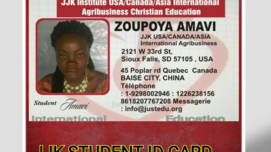According to the statistics from the Food and Agriculture Organization of the United Nations (FAO), 25 percent of West African suffered from malnutrition in 2001- 2003 .This is not surprising at all, for despite having livestock of more than 5 millions cattle, 7 millions sheep and goats, one million and two hundred pigs, the meat consumption per inhabitant per annum was only 15 kg in 2005, which is far less than the 42 kg recommended for a balanced nourishment.
Subsahara Africa depends on foreign trade to satisfy the 87 percent of its need in rice, 38 percent of its needs in fish, 100 percent of its need in soybean meal, and a not negligible part of its need in vegetable oils. Therefore, the country has not escaped from the soaring food prices that hit the world between 2007 and 2008.This situation has aggravated poverty causing deadly riots in February 2008.It is important to precise that the FAO already estimated the national level poverty rate to about 40.2 percent in 2001!
Despite the policy measures taken by Governments exempting common foodstuff importations from taxes and aiming at boosting agricultural production by distributing funds for seeds and fertilizers to small scale farmers, the problem of food insufficiency still prevails. The international crisis, with its consequences in term of dismissals has not made things any better.
According to the OECD- FAO Agricultural Outlook 2009 – 2018 report, although food prices have come down from the record peaks of early 2008, they are projected to be 10 – 20 percent higher for the next 10 years compared with the average for the period 1997 – 2006.
Concerning vegetable oil prices; they are expected to be more than 30 percent higher. This report also argues that, although agricultural production, consumption and trade are expected to increase in developing countries, food insecurity and hunger will remain a growing problem for poor. Therefore, it is absolutely vital to produce abundant and affordable food for poor in those countries.
OVERALL OBJECTIVES
- Affordability and availability of common foodstuff for local and regional populations.
- Availability of cheapest sources of proteins
- Employment for the local population
- Exports earnings for the country
- Benefits for Cameroon in term of taxes and revenues
- Benefits for other investors
potential investors are kindly invited to participate to this ambitious project, located in one of the most peaceful and stable countries in Africa and in the sector that have proven more resilient to global crisis
paradoxically, West and Central Africa is endowed with much natural potentials such as:
- 7.2 millions of arable lands in which only 26 percent are exploited.
- 268 Km3 per year of renewable internal surface water resources.
- 100 Km3 per year of renewable internal underground water resources
- 4 millions hectares of inland stretch of water.
- Good and constant rainfall
The country is divided into five Agro ecological zones with favourable conditions for the cultivation of many crops such as rice, maize, soybeans, sorghum…etc.
Car Dieu n'est pas injuste, pour oublier votre travail et l'amour que vous avez montré pour son nom
Just Jesus King (JJK)
Jesus support Agriculture & Entrepreneurship education
for Africa.









